Implications of labour markets for the social care workforce: report
Independent research on the influence of national and local labour markets on the social care sector.
4 Perceptions of Working in Social Care
Key Findings
- The desire to make a difference to people’s lives is the main reason why people join the social care workforce. However, people in rural areas appear to be more likely to be influenced by the availability of job opportunities in their local area.
- There are key differences between adult and children’s services[115] - workers in children’s services are more strongly motivated to make a difference to people’s lives when choosing this career than adult services workers, and the job flexibility and availability of job roles in the local area were also stronger motivators, particularly for staff with no previous work experience.
- The working environment also has an important role to play in motivating some people to join the sector. The fact that social care is a practical job with variety rather than being routine or desk-based is perceived as being attractive to potential recruits.
- People working in adult services are more likely to report being motivated by doing a job that others may not be able or willing to do, perhaps reflecting the perception that some of the tasks associated with working with older people may discourage people from considering a career in this sub-sector.
- There are key variations between different service providers, particularly in terms of access to career, progression and training opportunities, and flexibility.
- The main reason why people leave the workforce is to enhance their income. This supports previous research showing that levels of pay in the social care sector is the main reason why employers can face challenges in recruiting and retaining key workers. This is particularly significant in the independent and third sectors where the differentials in pay and conditions suggests that staff appear to move from independent and third sector to the public sector.
- People are also likely to leave the social care sector where there are opportunities to work in what they consider to be less demanding jobs for the same or a better rate of pay. This is not necessarily for career progression.
- Most employees think that the employment opportunities in the sector are good, and they tend to rate these more highly than career progression opportunities. This suggests there is work to be done in communicating better career progression pathways so that the sector is seen as not just one that provides employment, but as one that supports staff to develop and progress.
- In remote and rural areas, there are implications for social care workers in terms of travel to work and service delivery. Their working environment, and choice of jobs, can therefore be quite different to their counterparts in more urban areas, and employees in more rural areas are more likely to report that opportunities to develop their career are very or quite poor.
Introduction
4.1 The social care workforce sits within the wider social service sector, including all registered care services and ‘social work services’ and local authority social work services. The social services workforce includes both children’s services (i.e. adoption services, fostering services, residential childcare and fieldwork services) and adult services (i.e. adult day care, adult placement services, care homes, housing support/care at home for adults, nurse agencies, offender accommodation services, and fieldwork services).
4.2 This chapter considers the drivers and influences in the social care[116] workforce that impact on people’s decision to undertake a career in social care, and encourage them to either stay in or leave the sector. It is important to understand these factors in order to inform workforce planning and enhance recruitment and retention for example, through a major national recruitment campaign which is currently being planned. The findings in this section are largely based on the survey of social care employees and employers, with additional input from stakeholders.
4.3 The evidence set out in this chapter (and also in chapters 5 and 6), is drawn largely from the employer survey responses and consultations. Public sector employers will undoubtedly face challenges but they find it easier than equivalent providers in the third and independent sectors due to the perception that the public sector has significant advantages such as the conditions that they can offer.
Choosing a career in social care
4.4 This section examines what influences and motivates people to join the social care workforce. The following tables are – in common with much of the evidence in section 5 and 6 – taken from employer and employee surveys undertaken as part of this research. The survey reported that the most significant factors are making a difference to people’s lives, and a passion for the profession, as illustrated in Figure 4.1. This demonstrates the importance to people in the workforce of having a sense that they are undertaking a worthwhile job and is a useful message to communicate to potential recruits and also, to encourage people to remain in the workforce and progress their career. This point is reinforced by some of the comments made by employees around what could be done to encourage people to join the social care workforce, including the following:
“Better promotion of the benefits - particularly the difference you can make to the quality of someone's life” (public sector, urban/rural housing support/ care at home employee)
“Ensure that there is clear advertising that this is a career that is secure, varied and rewarding” (third sector, urban/rural housing support/ care at home employee)
“[Promotion of] the difference that you can make to an individual/family life” (public sector, urban adoption and fostering services employee)
4.5 Survey respondents who had joined the adult service social care workforce from another sector (and those with no previous work experience) were more likely than those with previous experience to be attracted by the flexibility of the job and by the availability of jobs in their local area. As Figure 4.1 shows, people with no previous work experience were most likely to be attracted by the career progression opportunities in adult social care and least motivated by financial rewards.
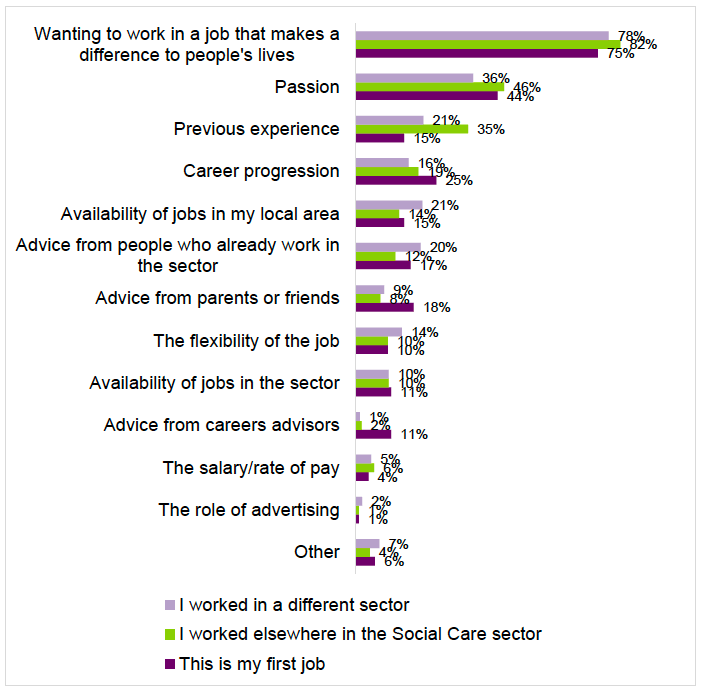
Source: ekosgen employee survey, n=2,804
4.6 When comparing these findings to those illustrated in Figure 4.2, it appears that the desire to make a difference to people’s lives is a slightly stronger motivating factor when choosing a career in children’s social care services than in adult services. The flexibility of the job, and the availability of jobs in the local area were slightly greater motivating factors to those choosing a career in adult’s social care services. However people with no previous work experience were far more likely to choose a social care career in children’s services based on the job flexibility and availability of jobs in their local area.
4.7 Interestingly, the financial rewards are also perceived to be more attractive when people are motivated to join the social care workforce in a children’s services role although this is not significant.
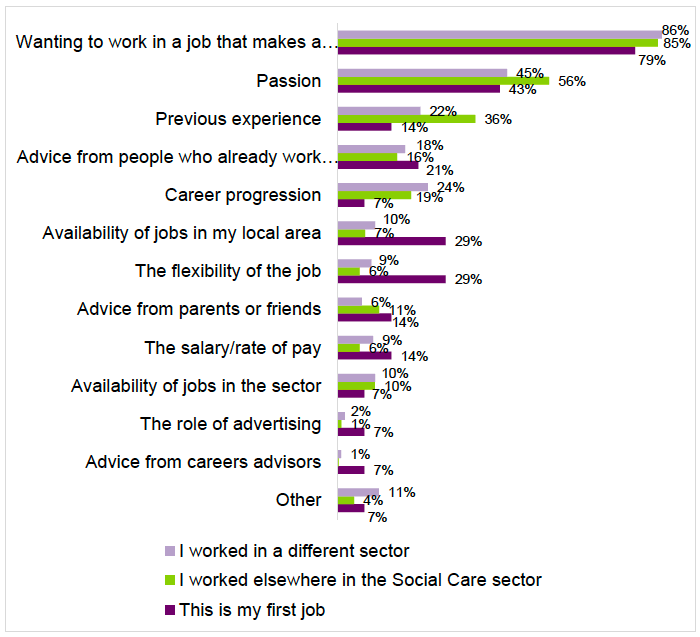
Source: ekosgen employee survey, n=489
4.8 The type of area that social care employees live in has a significant impact on their reasons for joining the workforce. As Figure 4.3 shows, workers in all types of areas are mainly motivated by doing a job that makes a difference to people’s lives. However, in rural areas, people are also more likely to be influenced by the availability of employment opportunities in their local area, probably reflecting that in rural parts of Scotland, job opportunities may be more limited than in predominantly urban areas[117].
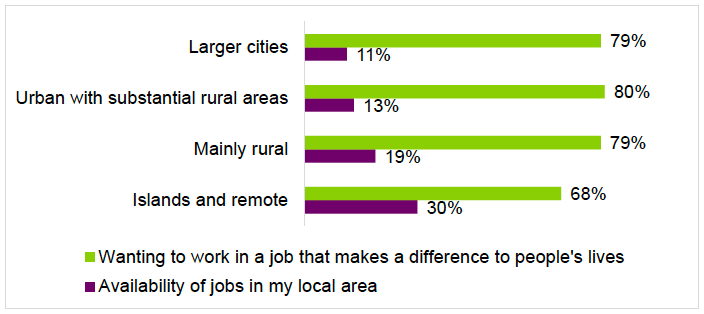
Source: ekosgen employee survey, n=4,406
4.9 The survey looked at the main drivers that encourage people to join the social care workforce. As before, the majority of employees are motivated by a sense of by job satisfaction and by a desire to make a difference to peoples’ lives. Added to this, more than two in five employees (41%) said that they identify with their service users as shown in Figure 4.4. The figure shows interesting differences between the views of employees and employers.
4.10 The working environment also has an important role to play in motivating some people to join the sector. Just under a fifth of employees (18%) identified the fact that it is a practical job rather than being desk–based, and over a quarter (27%) were motivated by the job variety.
4.11 Reflecting the anecdotal but persistent perception that there is a lack of career progression opportunities in social care and that it provides ‘just a job’ rather than a ‘career’, only 14% said that career and progression opportunities were motivating factors in joining the workforce. We must of course recognise that some workers may not aspire to or be interested in progressing in their career for a variety of reasons.
4.12 However this perception varies by area, with people living in larger cities being almost twice as likely as those in islands and remote areas to be motivated by career and progression opportunities (15% compared to 8%). Whilst we cannot be sure of the reasons, it may be that in urban areas there are more opportunities to progress in the sector either within their current employer, which may be larger than in rural areas, or by moving to a new employer or to a job in a different sector.
4.13 There are some differences between employee responses in the public, independent and third sectors. Desire to make a difference was slightly less of a motivator for independent and public sector employees at 56% and 57% compared to 63% for third sector employees. Third sector employees are more likely to be motivated because they identify with service users but less likely to be motivated by training opportunities than their counterparts in the independent and public sectors. Perhaps not surprisingly public sector employees are more likely to report that a perception of job security motivated them.
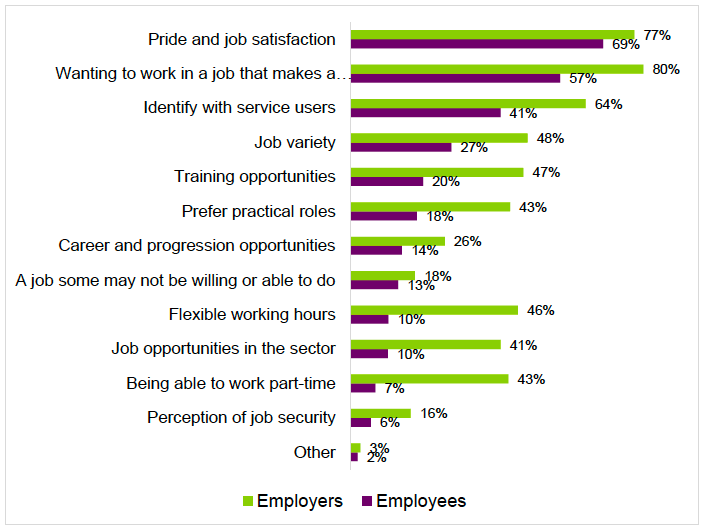
Source: ekosgen surveys, employee n=3,988, employer n=614
4.14 Generally employers are more likely to report a broader range of motivating factors than employees. Interestingly, at 47%, employers were more likely than staff to report training opportunities as a motivating factor for people choosing to work in social care. This may point to a lack of awareness amongst employees of the opportunities, or an over-optimistic view on the part of employers. Either way, there is clearly a mismatch which is an important consideration in future workforce planning and development. This suggests that employers should be doing more to help potential and current workers to learn about social care roles, for example, highlighting the value of training, or the potential for job variety within the sector.
4.15 The survey’s findings suggests that employers believe that the opportunity to work part-time is a key motivation for joining the workforce. The SSSC workforce data indicates that just under half (49%) of the workforce are classed as part-time employees, and the median weekly hours for staff is 31.5[118]. A key overriding is that work patterns are driven by a need to deliver personalised and high-quality services but need to be balanced alongside the needs of employers and their workforce. Future studies could explore the implications of these competing priorities and the implications for service delivery and recruitment.
4.16 Eleven per cent of the social care workforce work part are on zero hours contracts[119]. However, there is a concern that whilst zero hours contracts can offer flexibility, they can be driven by the preference of employers rather than what would best suit employees. There is widespread recognition that zero hour contracts can make financial planning and home life more challenging for employees[120]. The flexible working arrangements - including the availability of shift patterns and the ability to work part-time - are greater motivating factors for people who had joined the social care workforce from a different sector. This is an important message for future national recruitment campaigns and workforce planning.
4.17 Figure 4.5 shows that the extent of the range of types of employee motivations can vary widely between children’s and adult services. Whilst more than four in five people (81%) working in children’s services report that the desire to make a difference to people’s lives is the most significant motivation for joining the workforce, the corresponding figure for staff in adult services is 52%. However, Figure 4.1 looks at this point in a slightly different way, asking respondents what influenced them. It shows that wanting to make a difference was more influential, as reported by employees in adult social care. In both cases, respondents were asked to select the top three reasons and the options provided were slightly different, reflecting the difference between influence (which includes advice from influencers such as parents and careers advisers, and job advertisements) and motivation which is more about job content and context.
4.18 Figure 4.5 also shows a marked difference between staff working in adult and children’s social care services when it comes to identifying with service users (45% compared to 33%). People working in adult services are also more likely to report being motivated by doing a job that others may not be able or willing to do.
4.19 The findings are similar to the personal assistant (PA) research, where the most common reasons for respondents becoming a PA were pride and satisfaction in the job and wanting to make a difference to someone’s life (both reported by 67% of PAs). The PA workforce is a key part of the social care sector, but is quite distinct from it in some ways. To reflect this, a separate survey was undertaken with PAs and their employers. Twenty PAs completed the dedicated PA survey while a further 56 competed the main survey. Where possible we have merged the results and covered them separately within this report where relevant. [121] Although these are quite small samples, they still present interesting findings to build on.
4.20 The job variety and flexible working hours were also motivators for PAs, while job security, employment opportunities and progression opportunities were not motivators for PAs, similar to the wider social care workforce.
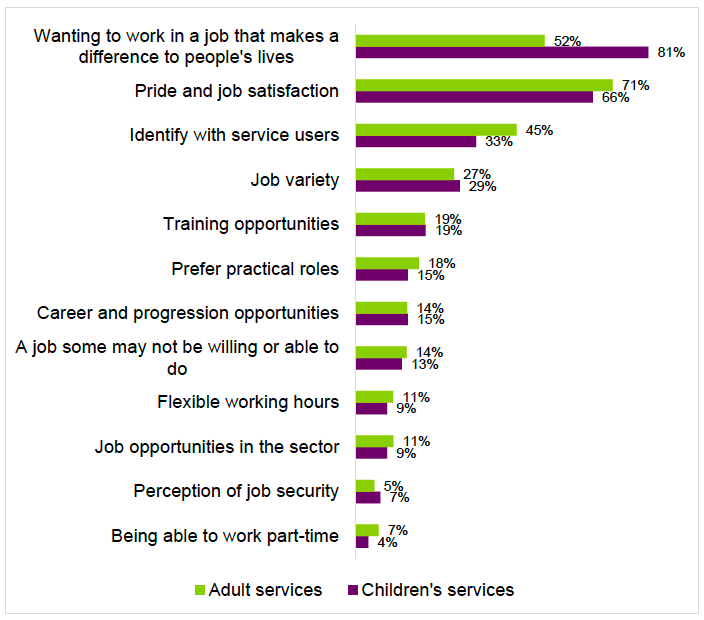
Source: ekosgen employee survey, Adult services n=2,796, Children’s services n=488[122]
Workforce retention
4.21 The research explored the reasons why, once people enter the workforce, they choose to remain. As Figure 4.6 illustrates, these factors largely mirror the motivations for joining in the first place. Having said that, people are more likely to identify with and care for their service users once they are actually working with them.
4.22 Just over half (54%) of people working in adult services report that the desire to make a difference to people’s lives motivates staff to stay in the workforce. The corresponding proportion for people working in children’s services is 75%, which is a substantial difference.
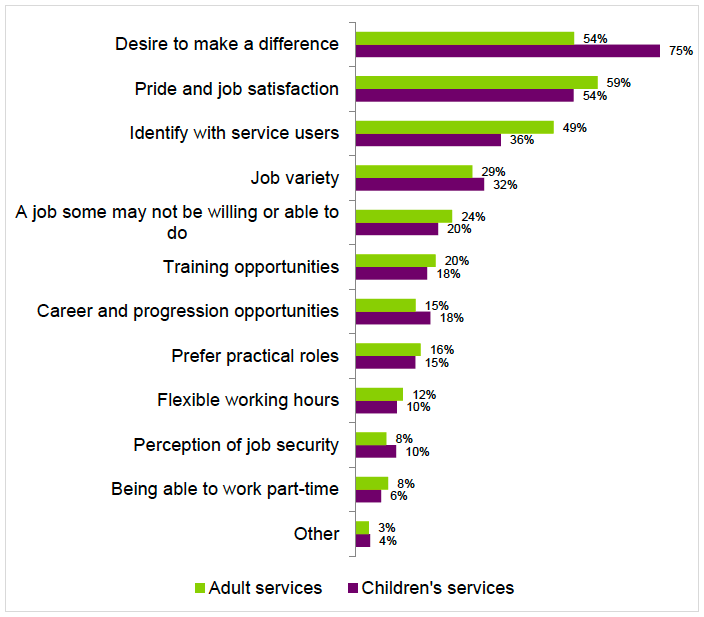
Source: ekosgen employee survey, Adult services n=2,788, Children’s services n=487[123]
4.23 People working in adult services (24%) were slightly more likely than those working in children’s services (20%) to identify that the enjoyment of doing a job that other people may not be willing or able to do is a reason why people stay in the workforce. These proportions are slightly higher than the proportion of all social care employees (18%) reporting this reason as a motivation for people to join the workforce.
4.24 It is worth noting that people working in adult services are more likely to perceive that their job may be less attractive to other people (doing a job that others may not be able or willing to do) than people working in children’s services. Careful consideration of this point could help to inform future recruitment and retention that successfully reaches in to a wider pool of people.
4.25 There are other minor variations between services. People working in adult services (15%) were less likely to rate career and progression opportunities as drivers to stay in the workforce than those working in children’s services (18%), which may reflect the fact that people are less aware of career and progression opportunities.
4.26 Many social care workers are required to have a suitable qualification, or be working towards one. Evidence from stakeholder consultations undertaken as part of the research points to a degree of concern that some experienced workers who do not currently have a qualification, particularly those near retirement age, might choose to leave the sector rather than undertake a qualification. Whilst the drive towards achieving and recognising formal education and training is seen as a positive one, Scottish Care have reported that many employers would value more flexibility and scope to acknowledge and develop skills and attributes in other ways[124]. They suggest that a review of the SVQ structure could be considered, in order that its strengths can be retained and built upon whilst ensuring learning opportunities will prepare people for the demanding, varied and complex job of providing care.
4.27 Whilst career progression opportunities are not seen as a significant driver for staff to remain working in social care, public sector employees rate career progression more highly as a motivator which may reflect the fact that public sector bodies are generally much larger than independent and third sector providers and so there are more opportunities for progression and more varied job roles within the public sector. This may, in turn, attract those interested in greater career opportunities. As illustrated in the SSSC’s first analysis of workforce movement, there is evidence of career progression in the sector (for instance from care home supervisors to managers, or ELC support workers to practitioners)[125].
4.28 Figure 4.7 illustrates that 17% of both independent and NHS employees (and 16% of public sector employees) identified career progression as a motivator to remain in social care, compared to 12% of third sector employees. This perhaps reflects that progression opportunities are, or are perceived to be, more readily available, pathways clearer and there is a wider variety of roles in these sectors. The point about lack of career progression is exacerbated by the fact that job security is seen to be less of a motivator amongst independent sector employees and third sector employees (both 5%) compared to public sector employees (12%). The recent Benchmarking Survey for the CCPS identified that third sector providers face issues around loss of contracts, for example through services being retendered and budget cuts. Illustrating the challenges, four providers reported that they had handed back contracts to local authorities as they couldn’t deliver them[126]. Scottish Care research[127] found that 86% of services are concerned about their sustainability, with nearly a quarter saying that they are extremely concerned and the challenge of recruiting and retaining staff is the main reason why services feel they may not be able to sustain care delivery. Naturally this lack of confidence amongst employers can give employees and potential employees a sense that jobs in the third and independent sectors are less secure.
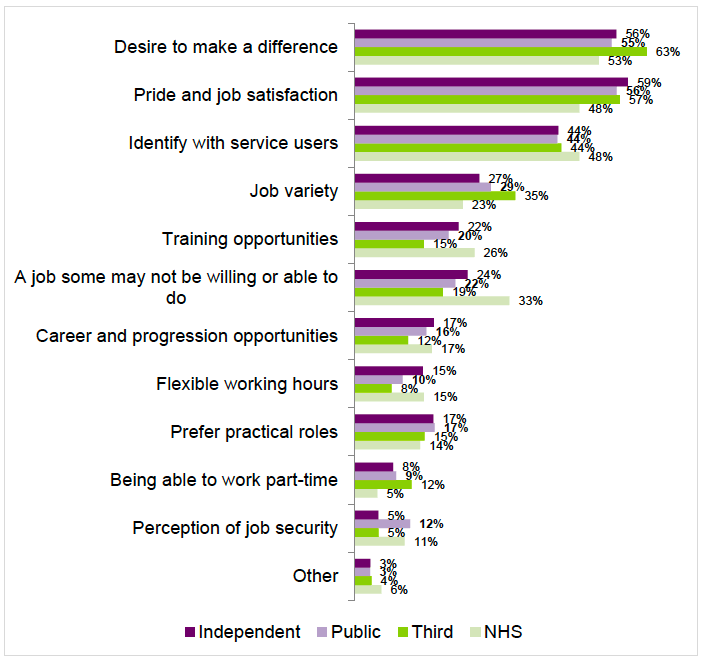
Source: ekosgen employee survey. Independent n=1,637, Public n=1,482, Third n=535, NHS n=120[128]
Reasons for leaving social care
4.29 Formal registration (with the SSSC) and qualifications are now expected within the social care workforce, and roles and tasks are changing and in many cases, becoming more complex. Arguably, levels of pay and rewards have not changed sufficiently to reflect the increasing demands of providing care although the Real Living Wage has undoubtedly had a positive impact on pay in adult social care[129]. The implementation of the Real Living Wage has, anecdotally, put pressure on some providers. For some employees, the issue of low rates of pay has been compounded by the fact that travel time to see service users in their homes is not always paid.[130]
4.30 Figure 4.8 sets out employee perspectives on the reasons why people leave the social care sector, as reported by all survey respondents. It shows that the main reason is to enhance their income, and this is particularly the case in the independent and third sectors. There is a need for a better understanding of the movement of workers between the independent, third and public sectors and the SSSC will be examining this as part of their next analysis of the Register. This evidence supports previous research that shows that levels of pay in the social care sector is the main reason why employers can face challenges in recruiting and retaining key workers.[131] It can also work against developing a more diversified social care workforce. The following comment from an employer highlights this issue:
“We are losing staff all the time to go and work for the local authorities. The feedback we receive is that they would choose to work for the council over the private sector because of pay. The private sector just cannot compete” (independent sector, urban/rural child care agency employer)
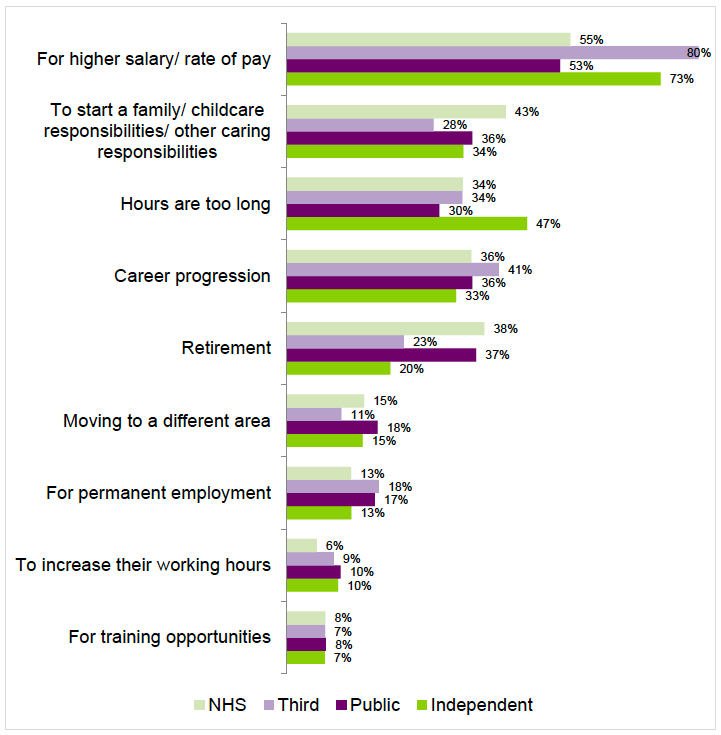
Source: ekosgen employee survey, Independent n=1,637, Public n=1,475, Third n=527, NHS n=120
4.31 Long working hours was a significant reason for leaving the workforce for those working in the independent sector. Care homes for adults workers (43%) and care at home/housing support workers (40%) were most likely to report that the long hours are likely to encourage people to leave the workforce. Employer’s perceptions were very different to employees, and employers were far less likely to report staff leaving their service due to long working hours. This suggests that a better understanding by employers, and change to working hours, could potentially significantly improve retention.
4.32 There are also concerns that some people might leave the social care sector where there are opportunities to work in what they consider to be less demanding jobs for the same or a better rate of pay. The following statement from an employer illustrates this point:
“Few people are drawn to work in this sector in this area - we are competing with employers who offer much better terms and conditions of employment with jobs that carry much less responsibility and much higher status” (independent sector, rural school care accommodation employer)
4.33 Reflecting the issues of unattractive terms and conditions, two thirds of all social care respondents identified pay levels as one of the main reasons why they leave the workforce. However as Figure 4.8 shows, there are substantial differences in responses by sector, which is a significant finding. Third sector and independent sector workers are much more likely to identify pay rates as a reason for leaving than workers in the public sector (80% compared to 53%). Research suggests that the introduction of the Real Living Wage has helped to improve the pay levels of workers in some roles and parts of the social care workforce and has had a positive impact on the income levels of some workers[132]. Other benefits included in public sector terms and conditions also contribute to a more attractive overall package. Further clarification about different types of Living Wage is outlined in Appendix D.
4.34 The survey asked employers to identify the three main reasons they believe make employees leave the social care workforce and the findings are set out at Figure 4.9. It shows that over half of employers in the survey believe that staff leave to move into jobs with higher rates of pay. As well as discouraging people from joining the social care workforce the perception of limited career progression opportunities can mean that employees are not incentivised to develop their skills as they do not see a clear progression pathway. Almost half (46%) of employers identified lack of career progression as a reason why people leave the social care workforce. Chapter 6 explores the reasons why staff who have ambitions to leave, want to leave.
4.35 Caring responsibilities is also an important reason with 17% of employers identifying that caring for children or other dependents is a factor in their decision. A 2015 study by the Scottish Government indicated that there are an estimated 759,000 carers aged 16+ in Scotland and a further 29,000 young carers[133]. Recent research from Carers UK suggests that one in seven of the UK workforce care for a dependent, and that almost half a million people in the UK have left their job in the last two years to do so[134].
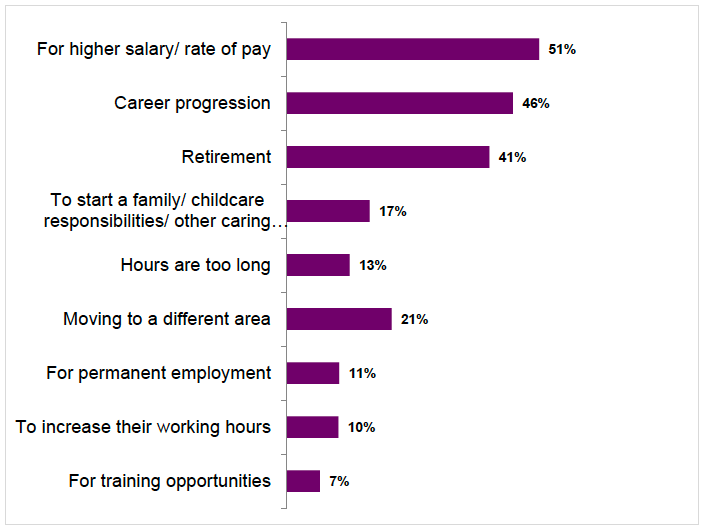
Source: ekosgen employer survey, n=565
4.36 Part two of the National Health and Social Care Workforce Plan outlines the need to ensure that social care becomes a positive career of choice for people at all stages of life[135]. However it recognises that improving career opportunities that acknowledge the variety of responsibilities and skills required in social care roles is a key challenge. As Figure 4.10 demonstrates, at 64%, most social care employees responding to the survey think that the employment opportunities in the sector are good, which is a very positive finding. It also shows that the employment opportunities in social care are rated more highly than career progression opportunities. This may reinforce the point that there is a need to better communicate career progression pathways so that the social care sector is seen as not just one that provides employment, but as one that supports staff to develop and progress. It could also be the case that some members of the workforce do not place a high premium on career progression. During recruitment, it might be useful to ensure that there is clarity about the job and progression opportunities available.
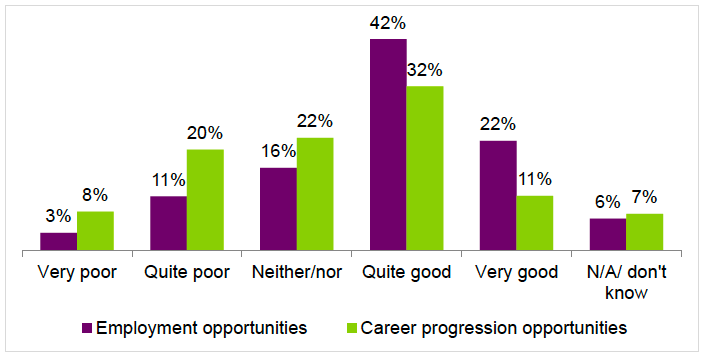
Source: ekosgen employee survey, Employment opportunities n=3,668, Career progression opportunities n=3,784
4.37 Underemployment[136], part-time working and out-migration of working age people are prevalent issues in rural parts of Scotland. As Figure 4.11 indicates, social care employees’ perception of employment opportunities in the sector shows some variation by type of area. Whilst the proportion perceiving the opportunities to be very or quite good is fairly consistent, people living in islands and remote areas are more likely to report that opportunities are quite or very poor.
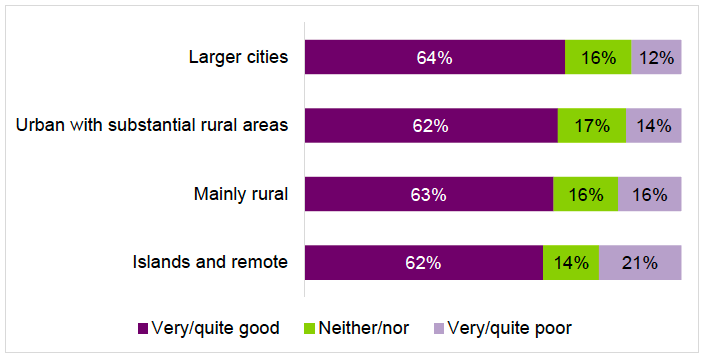
Source: ekosgen employee survey, Quite/very good n=2,549 Neither/nor n=663, Quite/very poor n=570
4.38 There is no doubt that there is a prevalence of underemployment in rural areas which can mean that skilled staff leave to find a job in which they can better use their skills as opportunities arise. It may in part be a lifestyle choice, but is also a reflection of more limited local opportunities and potentially higher proportions of part time working in rural areas[137]. There are geographic variations for example, the Shetland Islands has very low unemployment but very high underemployment.
4.39 Whilst the movement of under-employed workers affects all sectors, it will certainly have an impact on social care, particularly in rural areas.
4.40 There are also implications for social care workers in terms of travel to work and service delivery in remote and rural local authority areas (such as Shetland, Argyll and Bute and Na h-Eileanan Siar). They, and the service users, are often geographically dispersed, employees face longer travel times and tend to work in smaller teams and sometimes on their own. Their working environment, and choice of jobs, can therefore be quite different to their counterparts in more urban areas.
4.41 Figure 4.12 indicates that the variations on perceptions around career progression between different types of areas are not as marked as we might expect. However, it is clear that in more urban areas, the greater the perception is that there are good or very good career progression opportunities. Conversely, the more rural an area, the more likely employees are to report that opportunities to develop their career are very or quite poor.
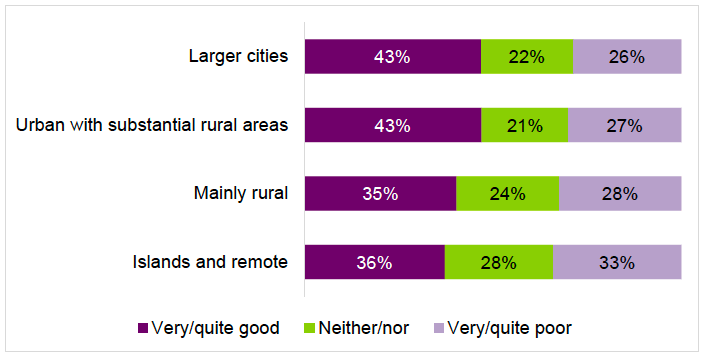
Source: ekosgen employee survey, Quite/very good N=1,691, Neither/nor N=938, Quite/very poor N=1,148
Contact
Email: ocswa@gov.scot
There is a problem
Thanks for your feedback